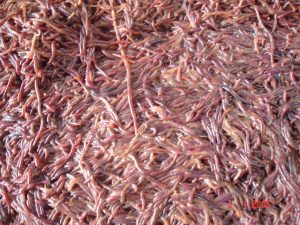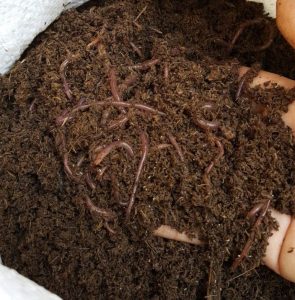Worm composting Vietnam – Red wiggler worms (Eisenia species) can be used for composting kitchen scraps and organics. This species of worm “red worms” or “red wriggler” is hardy and reproduces quickly. One pound of worms consumes up to 1/2 pound of food scraps per day.
Worm composting is an odor-free way to dispose of your kitchen waste. Another benefit of “vermicomposting” or worm composting is that it produces worm castings that are excellent plant fertilizer. Worm composting Vietnam can be done indoors or outdoors. Where we are located near Vancouver BC, our climate is mild enough for outdoor worm composting most of the year, but ideally a worm bin would be sheltered during prolonged freezes.
Worm Composting Bins:
There are many ways to set up Worm composting Vietnam: from a covered wooden box in your backyard to a ventilated tray system or modified rubbermaid bin for indoor use. About 1 square foot of bin is needed for each pound of worms. Make sure excess water can drain out of your bin either into the ground or into a collection tray. Another basic: protect the bin from hot sun and freezing.
Filling the bin: Worm composting Vietnam

Worm composting Vietnam
Your compost bin may come with instructions for how to begin, but here are the basics:
Fill your bin half full of bedding. Bedding can include some or all of the following: shredded cardboard, shredded newspaper, coconut coir, straw, or fallen leaves. This is the carbon-rich brown component required for composting. The worms will eat this bedding during the process.
Add some water to the bin to moisten the bedding. Red wiggler worms like a very moist environment for feeding and breeding.
Next, add a handful of regular garden soil to the bedding. Soil contains microbes and grit that they need to break down their food.
Also, if you are waiting for your worms to arrive in the mail, you can prepare the habitat a week or so before their arrival by adding the garden soil and a handful of vegetable scraps to the moist bedding to start the process.
The next step is to add the worms with their compost to the top of the bedding. They’ll crawl down into the bedding.
The last step is to bury a pailful of food scraps in one corner of the bin. The vegetables and fruit make up the nitrogen-rich green component required in composting. Food scraps that worms will break down easily include fruit, vegetables, egg shells, bread, pasta, rice, tea bags, and coffee grounds. It is recommended that meat and dairy be disposed of through your municipality, but tiny quantities of these mixed with your other foods shouldn’t be a problem. Foods that red wigglers don’t like are raw potato peels, onions, oily sauces, pineapple, citrus, salty foods, and chilies, so do not add large quantities of these items to your worm bin.
The worms will begin to feed on the food scraps in a couple of weeks.
Depending on your bin, you may wish to cover the bedding with a layer of moist newspaper or cardboard. Instructions for maintaining the bin once it is established are below.
Maintaining the worm bin: Worm composting Vietnam
After a few weeks the worms will be established and begin breaking down the first batch of food scraps and bedding. At this time you can add more scraps to different parts of the bin up to 1/2 pound of food per day per pound of worms. Adding scraps to different areas of the bin allows the worms to move towards the food supply that is ready for consumption at that time.
If the bin smells of rotten food scraps or if you have fruit flies, make sure you are burying the food scraps in the bedding. Add more bedding to the top if necessary. You may also want to add fewer food scraps for a while or move your bin to a cooler location. Part of the fun is experimentation.
Monitor the bin for moisture and add water if the bedding is drying out. Liquid can be emptied out of the bottom of a rubber bin, but if you have to do this more than once a month, you are adding too much water.
Collecting the finished Vermicompost:
After several months you can collect the earthworm castings. If you’re using a worm bin
the worms will migrate to the top trays so you can collect compost from the bottom trays.
With other types of bins there are a few other ways to collect the finished compost.
One way to separate the worms from the castings is to dump the bin onto a tarp under light. The worms will crawl to the centre and you can collect the top layers of soil. If you keep taking soil off, the worms will end up in a ball in the centre!
Another way to collect the castings is to start feeding the worms on just one side of the bin. After a few weeks, they’ll be gathered on that side and you can take the new castings from the other side.
When you’ve emptied a bin or section, fill it with fresh bedding to start the process again.
Where can I buy Red Wigglers Composting Worm?
Anphu Earthworm Co., Ltd
5/8 Streest No 15, Binh An Ward, Dist 2, Hochiminh City – Vietnam
Tel: 8498.3346179 – Fax: 8428-62810261
Email: wormvns@gmail.com
Zalo: +840983346179










